Friday 27 April 2012
Greater Grison -- South American Honey Badger
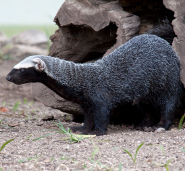
The greater grison (
Galictis vittata) resembles a thin
honey badger (
Mellivora capensis.) Both species are related. They both belong in the weasel family. The “grison” part of their common name is an English variation on the French word for gray, “gris.” Like the honey badger, the greater grison is a temperamental carnivore. The greater grison is so fierce that it is unknown what, if any creatures outside of humans hunt them.
Fortunately for both the greater grison and the honey badger, they do not meet each other because they live on different continents. The honey badger lives in Africa, while the greater grison lives in Central and South America. Its range extends as far north as Mexico and as far south as
Brazil. The greater grison is not listed as an endangered or threatened species by the International Union for the Conservation of Nature (IUCN.) This could be due to their adaptability. They make their homes in a variety of habitats, including grasslands and rainforests. They also do well in captivity and have been trained to hunt
chinchillas and other small animals for people.
Physical Appearance
The head, forelegs and underside of a greater grison is covered in short sooty black fur while the back, sides and hind legs are covered in longer, silvery-gray fur. The body is long and slim with the hindquarters higher than the top of the animal’s head. The head is wedge-shaped with small, rounded ears and small, dark eyes. The legs are comparatively short to keep the greater grison low to the ground.
Males usually grow larger and heavier than females. From nose to the base of the tail, adults grow to a body length of 18.5 to 22 inches (47 to 55 centimeters.) The tail can grow anywhere from 5.5 to 8 inches (14 to 20 centimeters.) Adults weigh from 3.25 to 4.5 pounds (1.5 to 2 kilograms.)
Life Cycle and Behavior
The greater grison lives near water, under rock formations or under tree roots. Adults live in mated pairs but sometimes live alone. This creature is fiercely territorial and fights with any other greater grison that crosses its territory. The average territory size is 2.6 square miles (4.2 square kilometers.) Greater grisons sleep during the day and hunt at night, dusk and dawn. They eat fruits but mostly eat meat from large insects, frogs, snakes, lizards, small birds, eggs, chicks and small mammals like mice.
The mating season is in October. After a 40 day gestation, the female gives birth from 2 to 4 young, sometimes called “puppies.” The female does most of the work raising the young and teaching them to hunt. She nurses them for only a few weeks. With luck, a greater grison can live 10.5 years.
Picture of the greater grison by
Tony Hisgett, licensed under the
Creative Commons Attribution 2.0 Generic license.
You can help spreading the word about this animal by liking it on facebook
Permanent Link
Thursday 26 April 2012
Javan langur -- The Monkey With a Mane
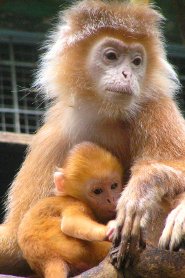
The Javan langur (
Trachypithecus auratus) is a large monkey that sports a mane like a lion. They are also known as an Ebony letung or Javan letung. The adult Javan langur has long, black hair, which grows forward around the shiny black leather-like face giving it a unique look. The neck and chest are brownish colored. Some of the langurs are a reddish-gold in color even though black is the dominant color. The infant langurs are orange-red in color. Langurs weigh from 7.1-18.1 kg (15.7-40 lbs.). The Javan langur measures 44-65 cm (17.3-25.6 in) in length with a long prehensile tail of 61-98 cm (24-38.6in). The langur is diurnal and arboreal and rarely goes to the ground. However, when they do travel on the ground, they use all four limbs to walk. The Javan langur is found in Java, Bali, and Lombok,
Indonesia. There are many different species of langurs that are found in India, Indonesia, and in Asia. The Javan langur resides in forested areas, mangroves, and fresh water swamps. These monkeys are herbivores and favorite foods include flower buds, flowers, ripe or unripe fruit, leaves, and occasionally insects and larvae. Researchers have also observed langurs living on teak plantations. All langurs have enlarged salivary glands along with an asacculated or chambered stomach to aid in the digestion of the cellulose plant material they consume.
The Javan langur is sexually mature at age 3-4. The females give birth to one offspring every 18-21 months. Gestation is 170-200 days, and the infants are born able to see and move around. The infants become independent at 1 year old and the adolescent males then leave the group or troop. They live in all-male groups until old enough and strong enough to become an alpha male. Each troop has one, or sometimes two males, and both of the males will both mate with the females in the troop. The Alpha males are also the protectors of the groups. Langurs are territorial and give out warning “hoots” to warn other troops. Males in the all-male troops rarely fight amongst themselves, whereas, the females tend to be more aggressive to other females within their troop. However, females care for all infants in the troop, which is known as allomothering. Langurs breed all year round so there are always infants in a troop. Troops usually have 7- 23 members.
The Javan langur is listed as “Vulnerable” on the IUCN Red List of Endangered Species. Humans are the only known predator at this time. Langurs are illegally hunted for food or captured alive for pets. The habitat of the Javan langurs is being destroyed by deforestation for human habitats, agriculture, and illegal logging. Fortunately, some of these adorable monkeys live on protected reserves.
Picture of the javan langur by
Belgianchoclate, licensed under the
Creative Commons Attribution 2.0 Generic license.
You can help spreading the word about this animal by liking it on facebook
Permanent Link
Wednesday 25 April 2012
Great Jerboa - Looks Like a Miniature Rabbit
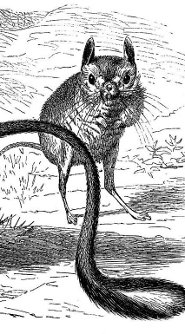
The great jerboa (
Allactaga major) is not a sandy-colored rabbit, despite having very long ears. It’s also not related to a kangaroo, despite hopping on its hind legs. This curious creature is a rodent, meaning its teeth grow throughout its life. There are 25 species of jerboas living throughout Asia and Africa. The great jerboa is the largest. In the past, biologists thought jerboas were long-eared gerbils, but now they know that jerboas are their own family of rodents.
There is not much known about the great jerboa because of their nocturnal nature and their extreme timidity. It is known that they are not in danger of extinction. They have a wide range in the arid grasslands, steppes and deserts of the
Ukraine,
Uzbekistan,
Turkmenistan and
Russia. It is thought their predators include birds of prey, foxes and
wolves.
Physical Description
Great jerboas possess the body of a gerbil with long ears, elongated five-toed hind legs and rabbit-like long ears. Their color is a sandy brown with a pale belly, chest and legs. Their eyes appear very large in comparison to the rest of the head. The eyes need to be so large in order for the great jerboas to navigate at night. The tail is much longer than the rest of the body. It is very slim with a white and black tuft at the tip.
Adults grow to a body length, excluding the tail, ranging from 3.5 to 6 inches (15 to 19 centimeters). The tail can grow from 6.25 to 8.5 inches (16 to 22 centimeters) long. Adults weigh very little in comparison to their length. Adult males and females weigh a mere 0.77 pounds (0.35 kilograms.)
Life Cycle and Behavior
Great jerboas spend their days sleeping underground in long burrows and chambers. They live in small family colonies. Underground is much cooler than the searing heat outside. They awake during sunset. They search far and wide to find seeds, roots, bulbs and insects. They obsessively comb through the sand with the toes of their forefeet to find food. Their huge ears make it easy to hear any danger. Great jerboas have to eat whatever they find instead of saving food for later.
The breeding season is in the spring around April and May. Female great jerboas have one litter a year and about 4 babies in each litter. When winter sets in, the great jerboas go into their burrows and hibernate in a group for five months. With luck, a great jerboa can live to be five years old.
Picture of the great jerboa by
Gustav Mützel (1839–1893).
You can help spreading the word about this animal by liking it on facebook
Permanent Link
Monday 23 April 2012
Doria's tree-kangaroo
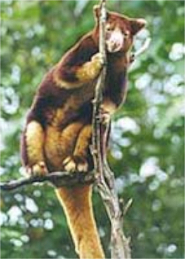
The Doria's tree-kangaroo (
Dendrolagus dorianus) is an unusual animal. It is a tree-dwelling kangaroo that can actually hop from tree to tree. The common name for these unique animals is Doria’s Tree Kangaroo. They are relatively rare as they are only found in the mountainous areas of southern New Guinea (
Indonesia) and southern
Papua New Guinea. On the red list of endangered species, Doria’s Tree Kangaroo is listed as “Vulnerable.”
Doria’s Tree Kangaroo is one of the largest of the tree kangaroos. They are nocturnal and spend most of the time as solitary individuals. It has a bear-like face and a stocky build. The weight of this species ranges from 6.5 to 14.5 kg (14.3-32 lbs). The body is 51-78 cm (20-31 inches) in length, with a long tail of 44-66 cm (17.3-26 inches). The fur of the Doria’s Tree Kangaroo is dark brown on the body, tan on the tail and under-body, and black on the ears. The tail is thick and is used for balance when climbing. The fur is rather long and grows backward on the neck and the back, which is thought to make those areas waterproof. Tree kangaroos are related to the Australian kangaroos, even though their appearance is quite different. The Doria’s Tree Kangaroo has large paws with long curved claws to aid in climbing. They can hop on the ground like other kangaroos, but can also jump from tree to tree about 9 meters (29.5 ft). The tree kangaroo leaves the tree by climbing down like a bear, or jumping down. The males mark their territory by rubbing the scent glands in their neck and chest on the bark of the tree as they climb. Tree kangaroos spend most of the day in the trees for safety reasons. They are hunted for food and are easy prey for the hunters who shoot them out of the trees. Due to logging and deforestation, the Doria's Tree Kangaroo's habitat and food sources are being threatened. The diet of the Doria’s tree kangaroo is comprised of leaves, buds, flowers, and fruit found in the forests.
The gestation period is 32 days, and only one baby is born. As with many marsupials, the baby is born undeveloped and must crawl into the mother’s pouch. The joey will nurse in the mother’s pouch for 300 days; however, they are not completely weaned until 600 days.
You can help spreading the word about this animal by liking it on facebook
Permanent Link
Friday 20 April 2012
Natal Duiker -- Tiny and Secretive Antelope
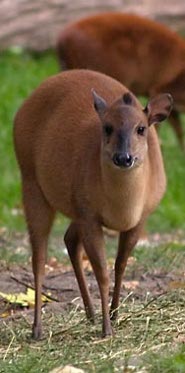
The Natal duiker (
Cephalophus natalensis) is a tiny, shy antelope that lives on the east coast of sub-Saharan Africa in the countries of
Malawi,
Mozambique,
Swaziland,
South Africa,
Tanzania and
Kenya. Although there have been reported sightings of natal duikers in
Zambia, some researchers believe that these animals may have actually been the similar Harvey's Duiker.
The majority of this compact, sturdy animal is a handsome red in color, which explains why it is also sometimes referred to as a red forest duiker or the natal red duiker. The underside of this antelope is slightly lighter in color. White hairs mark the natal duiker's chin and throat areas, and it carries a knob-like crest of hair on the top of its head. This tuft is often darker in color than the rest of the antelope, but other times it is the same red coloring.
Natal duikers typically stand about 40 to 45 centimeters at their shoulder, or about a foot and a half, tall and they are about 75 to 87 centimeters, or about 2 1/2 to 3 feet long, from head to tail. These antelope typically weigh about 14 kilograms, which is equivalent to about 30.86 pounds.
Both the females and males have short, straight, conical horns. Although female natal duikers are slightly larger than the males, they have smaller horns. These little antelopes typically give birth to one offspring a year.
Natal duikers, which have a hunched appearance, prefer living in thick brush near a ready source of water in coastal or riverine forests. The natal duiker can also be found in montane forests, as well as subtropical and tropical shrub lands.
Because natal duikers are extremely wary, they are rarely seen, so there is some dispute as to whether this animal is diurnal or nocturnal. When these antelopes are spotted, they are usually seen traveling alone or in pairs. Occasionally, they can be found in small family groups, as well. Natal duikers are territorial and mark their range with scent markers that are located near this antelope's eyes.
Natal duikers feed upon young shoots, leaves and fruits it finds on the ground. Because of its size, it is preyed upon by most predators, including
lions,
leopards, hyenas and even large raptors.
Unfortunately, the natal duiker is also extensively hunted by humans, and its flesh is commonly sold as bush meat in local markets. Still, the natal duiker is not considered endangered and it is currently listed as a species of least concern on the IUCN's red list. It is believed by some researchers, that this antelope may eventually disappear in areas where it is not protected, but because its population is fairly stable in protected areas, it probably won't become endangered in the near future.
Picture of the natal duiker by Der Irbis at de.wikipedia, licensed under GFDL and under the
Creative Commons Attribution-Share Alike 3.0 Unported license.
You can help spreading the word about this animal by liking it on facebook
Permanent Link
Thursday 19 April 2012
The Takin -- Gnu Goat
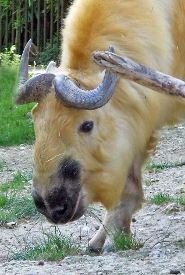
Evidence of the Takin (
Budorcas taxicolor) inhabit Northeast
India,
China, Tibet,
Bhutan, and Northern
Burma. Takins are also called a Gnu Goat or Cattle Chamois and are unusual animals in many ways.
They have the large shoulders and shape of a bison, the names of cattle, and look like a goat. Like other Bovines, they have hooves on their short stocky legs. Their long, bushy fur can be yellow, brown, or reddish-brown. A dark face marks the bulls, while on the cows and calves, only the nose is dark. All adult Takins have horns, but the female’s horns are smaller. Takins have broad hooves and well-developed dewclaws like goats, which allows them to climb the rocky mountainous terrain in which they live. Mornings and late afternoons are spent grazing on leaves, buds, and shoots, where they utilize another goat-like feature of standing on their hind legs to nibble on higher tree branches. Since they are grazing animals, Takins need to follow their food source. They prefer the mountainous areas for foraging in the warm weather, but in the winter when food is scarce, they live and graze in the valleys and forested areas. These animals are also unique for having a strange call to warn the herd of danger. They make a loud coughing sound and the herd reacts by running. A herd may have over 200 members in the summer, but when food is scarce in the winter, they travel in smaller herds of 20-30. The immature males stay with the herd for over two years. Older bulls are usually solitary travelers, except during mating season when they join the herd.
Bulls are large, averaging 210-220 cm (7-7.3 ft) in length and weighing 300-350 kg (660-770 lb.). Cows average 170 cm (5.6 ft) in length and range from 240-280kg (528-616 lb.) in weight. They mate in early summer and cows give birth to one calf the following spring. In 3-4 days, the young calves are able to follow their grazing mothers. Takin calves remain with the herd until they reach sexual maturity at 30 months of age. The average life span of the Takin in the wild is 12-15 years, while some have lived over 18 years in captivity.
The Takin is listed as “Vulnerable” on the Red List of Endangered Species. Due to excessive deforesting, the habitat and food sources of the Takin are being destroyed. In the same regard, Takins are becoming endangered by being legally hunted for food in some countries and illegally hunted in protected countries. The illegal hunters are difficult to catch due to the vast rural areas that the Takins inhabit. Many Takins are also killed each year by bears and
wolves, which are their natural predators.
Picture of the takin by
Steve from washington, dc, usa, licensed under the
Creative Commons Attribution-Share Alike 2.0 Generic license.
You can help spreading the word about this animal by liking it on facebook
Permanent Link
Wednesday 04 April 2012
Giant Mottled Eel -- Large Eel with a Long Migration
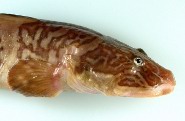
The mottled eel or giant mottled eel (
Anguilla marmorata) is an important source of food for many people living in tropical countries. Young eels are found in fresh water and brackish water in lakes, rivers and estuaries. Adults swim to the saltwater of the Indian and Pacific Oceans in order to breed. They are found as far north as
Japan and as far south as the Galapagos Islands. They also inhabit the African river of the Zambezi.
Because of overharvesting and water pollution, the giant mottled eel is rare in some of its usual habitat, but is not listed as an endangered species. However, the national government of Taiwan as declared it an endangered species. Attempts to introduce the giant mottled eel to Hawaii as a food source have failed, although individual eels are occasionally found living in the Hawaiian Islands.
Physical Description
Newly hatched larvae, called leptocephali, are shaped like tiny leaves. As they get older, they transform into miniature adults. Juveniles are yellow and black and go through a silver phase until they get their adult coloration. Adults are long, hose-shaped fish with small fins from the middle of the back and around the tail and right behind the gills. The skin is spotted shades of brown, green and grey in a pattern similar to a tabby cat. The undersides are pale gray to white. The small eyes perch on the top of the head. The mouth appears very large in relation to the rest of the body.
Females are usually larger than males. Females can grow to a length of 6.6 feet (2 meters) while males only grow to 4.9 feet (1.5 meters.) Full-grown males and females can weigh up to 45 pounds (20.5 kilograms.) Giant mottled eels are often harvested when they weigh only 26.45 pounds (12 kilograms.)
Life Cycle and Behavior
Giant mottled eels stay near the bottom of a water body, resting during the day and searching for food at night. Their varied diet includes frogs, crabs, fish and shrimp. They are unaggressive towards people. Their short front fins are strong enough for the eel to use as primitive legs so it can crawl from one body of water to another. They may do that during dry seasons. When they are anywhere from 8 to 20 years old, they become large enough to become sexually mature and move out to sea to spawn.
Eggs are lain in deep waters and when they hatch the leptocephali eat plankton until they are large enough to travel to brackish water. This is when they are about 114 to 132 days old. When they reach freshwater or brackish water, they transform into elvers or young eels. With luck, a giant mottled eel can live for 40 years!
You can help spreading the word about this animal by liking it on facebook
Permanent Link
 The greater grison (Galictis vittata) resembles a thin honey badger (Mellivora capensis.) Both species are related. They both belong in the weasel family. The “grison” part of their common name is an English variation on the French word for gray, “gris.” Like the honey badger, the greater grison is a temperamental carnivore. The greater grison is so fierce that it is unknown what, if any creatures outside of humans hunt them.
The greater grison (Galictis vittata) resembles a thin honey badger (Mellivora capensis.) Both species are related. They both belong in the weasel family. The “grison” part of their common name is an English variation on the French word for gray, “gris.” Like the honey badger, the greater grison is a temperamental carnivore. The greater grison is so fierce that it is unknown what, if any creatures outside of humans hunt them.
 The Javan langur (Trachypithecus auratus) is a large monkey that sports a mane like a lion. They are also known as an Ebony letung or Javan letung. The adult Javan langur has long, black hair, which grows forward around the shiny black leather-like face giving it a unique look. The neck and chest are brownish colored. Some of the langurs are a reddish-gold in color even though black is the dominant color. The infant langurs are orange-red in color. Langurs weigh from 7.1-18.1 kg (15.7-40 lbs.). The Javan langur measures 44-65 cm (17.3-25.6 in) in length with a long prehensile tail of 61-98 cm (24-38.6in). The langur is diurnal and arboreal and rarely goes to the ground. However, when they do travel on the ground, they use all four limbs to walk. The Javan langur is found in Java, Bali, and Lombok,
The Javan langur (Trachypithecus auratus) is a large monkey that sports a mane like a lion. They are also known as an Ebony letung or Javan letung. The adult Javan langur has long, black hair, which grows forward around the shiny black leather-like face giving it a unique look. The neck and chest are brownish colored. Some of the langurs are a reddish-gold in color even though black is the dominant color. The infant langurs are orange-red in color. Langurs weigh from 7.1-18.1 kg (15.7-40 lbs.). The Javan langur measures 44-65 cm (17.3-25.6 in) in length with a long prehensile tail of 61-98 cm (24-38.6in). The langur is diurnal and arboreal and rarely goes to the ground. However, when they do travel on the ground, they use all four limbs to walk. The Javan langur is found in Java, Bali, and Lombok,  The great jerboa (Allactaga major) is not a sandy-colored rabbit, despite having very long ears. It’s also not related to a kangaroo, despite hopping on its hind legs. This curious creature is a rodent, meaning its teeth grow throughout its life. There are 25 species of jerboas living throughout Asia and Africa. The great jerboa is the largest. In the past, biologists thought jerboas were long-eared gerbils, but now they know that jerboas are their own family of rodents.
The great jerboa (Allactaga major) is not a sandy-colored rabbit, despite having very long ears. It’s also not related to a kangaroo, despite hopping on its hind legs. This curious creature is a rodent, meaning its teeth grow throughout its life. There are 25 species of jerboas living throughout Asia and Africa. The great jerboa is the largest. In the past, biologists thought jerboas were long-eared gerbils, but now they know that jerboas are their own family of rodents. The Doria's tree-kangaroo (Dendrolagus dorianus) is an unusual animal. It is a tree-dwelling kangaroo that can actually hop from tree to tree. The common name for these unique animals is Doria’s Tree Kangaroo. They are relatively rare as they are only found in the mountainous areas of southern New Guinea (
The Doria's tree-kangaroo (Dendrolagus dorianus) is an unusual animal. It is a tree-dwelling kangaroo that can actually hop from tree to tree. The common name for these unique animals is Doria’s Tree Kangaroo. They are relatively rare as they are only found in the mountainous areas of southern New Guinea ( The Natal duiker (Cephalophus natalensis) is a tiny, shy antelope that lives on the east coast of sub-Saharan Africa in the countries of
The Natal duiker (Cephalophus natalensis) is a tiny, shy antelope that lives on the east coast of sub-Saharan Africa in the countries of  Evidence of the Takin (Budorcas taxicolor) inhabit Northeast
Evidence of the Takin (Budorcas taxicolor) inhabit Northeast  The mottled eel or giant mottled eel (Anguilla marmorata) is an important source of food for many people living in tropical countries. Young eels are found in fresh water and brackish water in lakes, rivers and estuaries. Adults swim to the saltwater of the Indian and Pacific Oceans in order to breed. They are found as far north as
The mottled eel or giant mottled eel (Anguilla marmorata) is an important source of food for many people living in tropical countries. Young eels are found in fresh water and brackish water in lakes, rivers and estuaries. Adults swim to the saltwater of the Indian and Pacific Oceans in order to breed. They are found as far north as